Anyway, to continue with the South African field season blog:
Friday, 20 Oct 2006.
I went to an Eskom nature reserve on the south coast, just east of Gaansbaai and Pearly Beach. I can't remember the name or spelling, so I'll leave that out. It's a reserve that's located on the limestone soils of the Agulhas plain, and I found a new species of Hyobanche there several years ago.
Usually I rent a 4X4 truck called a bakkie (pronounced "bucky"), but this year I saved money by renting a sedan. That's been ok for most of the trip, but not for driving in deep sand or on some of the back roads of South Africa. The first thing I did in going to my field site was to get stuck in the sand.

Yep, it's firmly stuck. No hope of going forward or backwards in this baby.
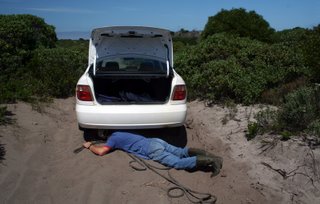
I called the reserve manager to ask him if he could send someone with a tow rope. A few minutes later a nice young man came with a bakkie and a rope. I don't have a trailer hitch on the rental car, but Raul was able to hook the rope to the back axle.

Connect the rope to the tow bar, and you're all set to pull a stupid car out of the sand.

A few seconds of pulling, and the car is unstuck. I hadn't driven very far past the gate before getting stuck. How embarrassing.

Back to firm ground.
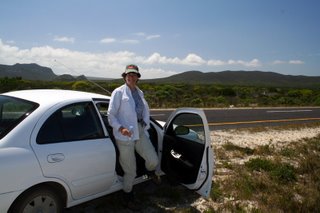
Is this a dumb American driver, or what? Actually, the problem is that I'm used to having a 4X4 and going where I want to go.

Well, anyway, we had success and found some of the new species still in late bloom and in fruit. Good enough to dig for host roots, but not as photogenic as when they're in their prime.
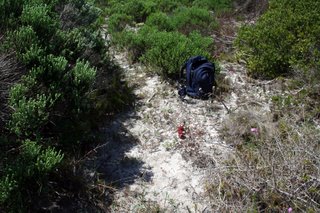
Here's a perspective on how they grow in their habitat. These plants are often out in the open, but can also be found under the shrubs.
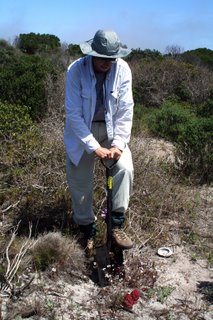
My first excavation was by shovel. I wanted to pop a plug and brush away the soil.
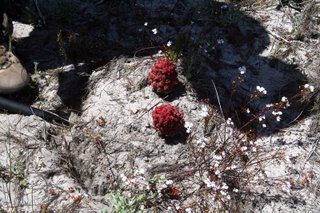
First you cut around the plants.
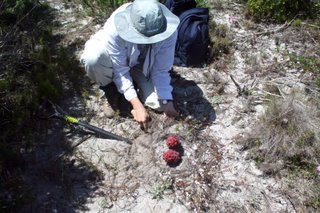 Then you dig a trench around the plug and start removing the soil up to around the plant. It's important to not break the host root connections since I need to have a positive attachment or I can't sample the root for the study. Unfortunately, the haustorial connections are generally very weak and I lose a lot of potential host roots. However, I have become pretty proficient at this sampling and I'm learning a lot about the host range of the species of Hyobanche I've collected over the past couple of years.
Then you dig a trench around the plug and start removing the soil up to around the plant. It's important to not break the host root connections since I need to have a positive attachment or I can't sample the root for the study. Unfortunately, the haustorial connections are generally very weak and I lose a lot of potential host roots. However, I have become pretty proficient at this sampling and I'm learning a lot about the host range of the species of Hyobanche I've collected over the past couple of years.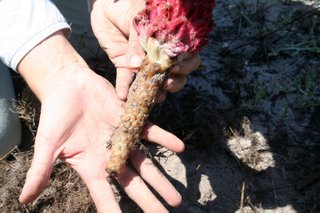
Here's a nice, juicy root that will yield a lot of DNA for the survey.

You can tell by my hands that this is pretty dirty work. The best method of excavation is literally by hand. That way I can feel the roots and the Hyobanche rhizomes and preserve as many connections as possible.
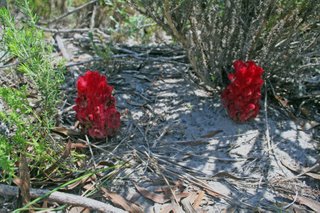
Here's another nice clump to sample.

Even though it's late in the flowering season, this plant is still very lovely (at least to this botanist's eye).

Here's how I get those beautiful pics. I have to get down and dirty, and up close and personal to photograph these root parasites. I seem to spend a lot of time in the South African dirt each field season.
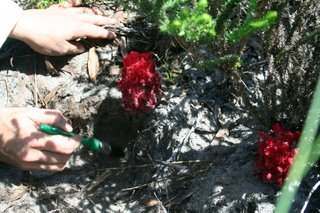
In addition to my bare hands, I use a paint brush to remove the soil from around the root connections. It's like being on an archeological dig.

This is a very successful excavation. You can see a lot of host roots down there with the parasite. Many of these were connected to the parasite and went into the survey as root tissue samples.
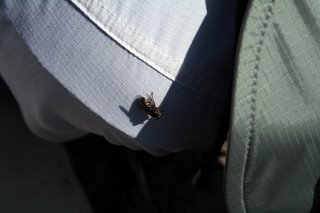
I've talked about the ticks I usually collect on my clothing, but I haven't yet mentioned the biting flies. Nasty buggars! They hurt!
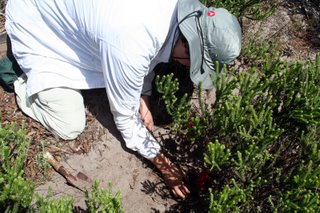
The things I do for science. . .

Well worth it in the end when I can sample those big roots. Yippee!

This is the coastal fynbos (pronouced Fane-bose) habitat where this species of Hyobanche occurs. It's dominated by Metalasia and Passerina - both known hosts as of 2004's work.

Unfortunately, this site has been heavily impacted by humans - in this case, abalone poachers. This is a classic snatch and run operation where the abalones were grabbed off the rocks (just past the dunes), the meat cut off and packed, and the shells and trash left lying onsite.

It really stinks here - the rotting meat is left and there is all sorts of other nasty waste around that I won't bother to mention. Abalone poaching is a huge problem in South Africa. I'm sorry to see it reach one of my best field sites.

I took some photos of other plants in the area. This is a succulent plant in the Mesembryanthemaceae (a big mouthful, but just call them mesembs like everyone else who works on them).
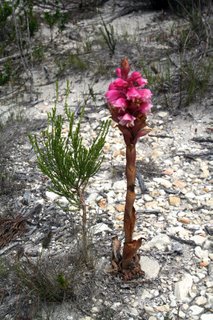
An orchid in the genus Satyrium.

Close-up of the same.
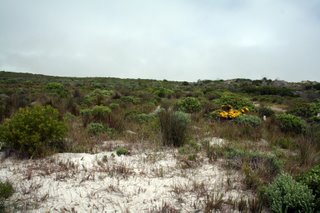
Another fynbos habitat pic.
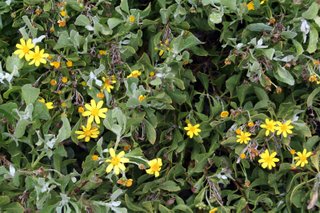
Chrysanthemoides - one of the host plants for some species of Hyobanche.
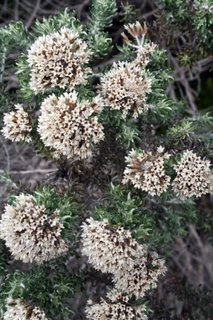
Metalasia - another Hyobanche host plant.

And now for something completely different. This is a huge Milkwood tree. Milkwood forests occur along the coastline and they are very rare and endangered.
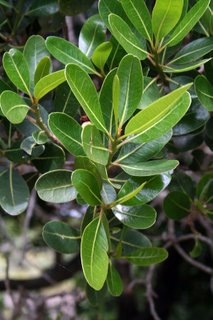
Here are the leaves of this tree. The wood is lovely for turning, but very hard to come by since it's illegal to harvest the trees. Fallen wood can be obtained by permit, and I have a milkwood bowl made by Mike Kaplan, which is one of my favorite turnings.

After finishing the fieldwork for the day, I drove back to Cape Town via Hermannus. On a lonely stretch of road between Gaansbaai and Hermannus, there were a lot of raptors perched on the telephone wires. I stopped the car to photograph this one - a Jackal Buzzard.
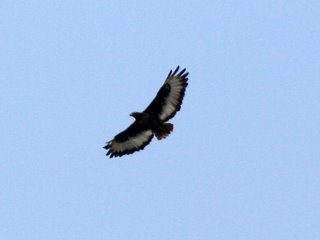
The coloration and wing patterns are very distinctive.

We stopped in Hermannus for a very late lunch (about 3 pm) and to do the touristy thing of looking for whales offshore. There's a nice park on the coast that is perfect for whale watching. I've also seen dolphins here in past years. We did see some whales, but they were pretty far away from shore.
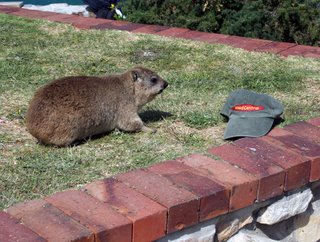
I did have some fun in messing with this Dassie. It didn't know quite what to make of my Woodcentral cap. It barked at it when Esprit tossed it over to him.
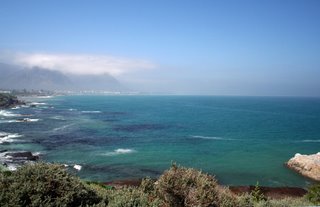
Here's the beautiful view from the park. The ocean is lovely.
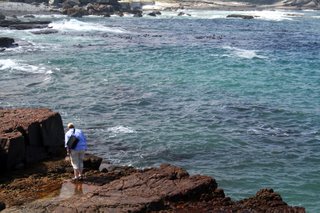
At low tide there are a lot of tide pools, but these didn't have very much diversity. Esprit had to go check it out, though.
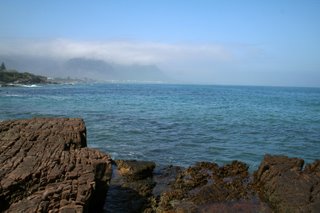
Another pretty view from the tide pools.
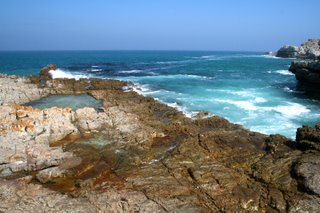
And another,

and one more.
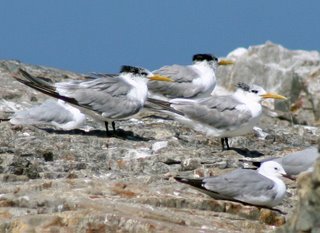
Some Swift Terns and a gull (I posted a pic of this gull from the waterfront).
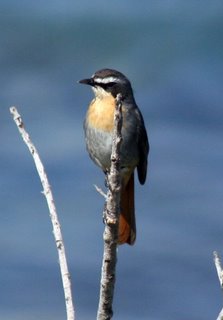
This is a Cape Robin and it was singing up a storm from this twig. The shrub was growing out of the cliff above the water.
Thanks for coming along for the ride. Stay tuned for the rest of the story. . .




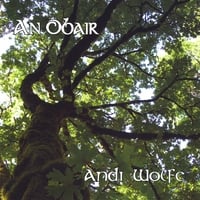






No comments:
Post a Comment